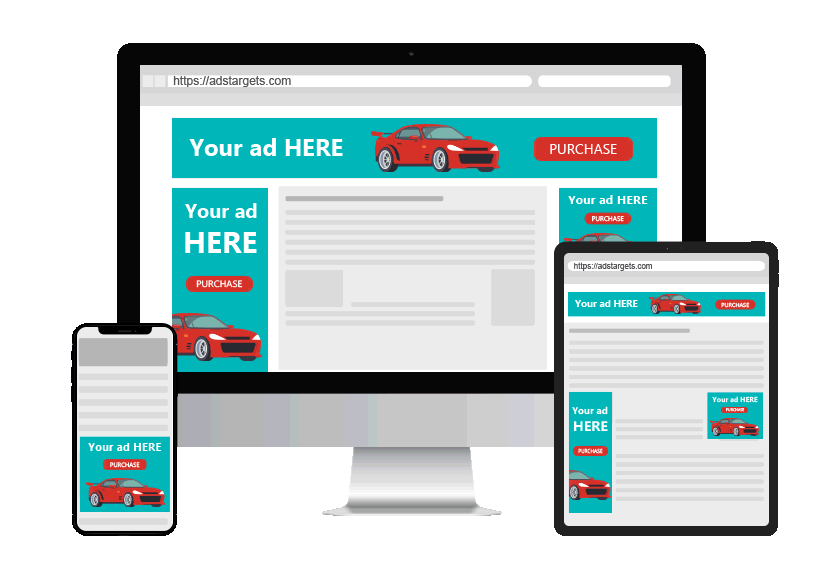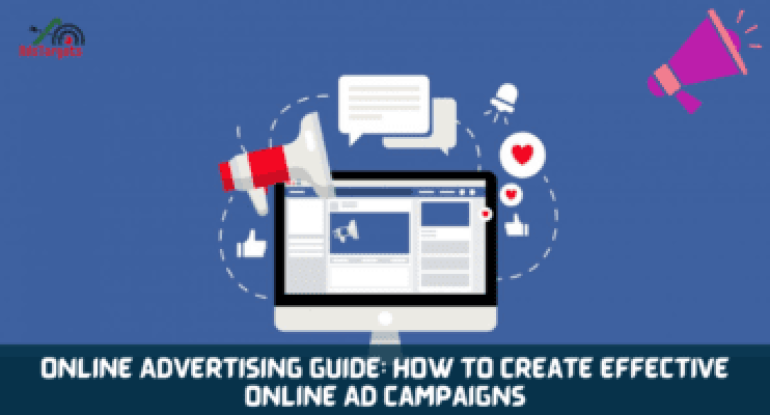In this post, you’re going to learn exactly how to create and implement an effective online ad campaign strategy.
An effective ad campaign is determined by the kind of blocks used at the foundation of it; a solid strategy is the first step towards getting positive returns on your ad efforts.
No matter what industry you’re in or whether you sell products or services, there’s no denying the benefits of creating a solid ad campaign.
Here are a few tips to ensure that your online ad campaign is up to the mark and help you achieve your digital marketing goals
Table of Contents
ToggleOnline Advertising: Paid Search
You pay some Dollars to a search engine when engine users search and click on your business link. With paid search, you classically pay the website owner to let them display your ad with a link to your offer or website, usually pay-per-click (PPC). This is the main revenue stream for all big businesses like Facebook and Google.
It is a way to drive more traffic to your website using money rather than waiting and relying entirely on organic reach. With paid search, you have to put a budget towards reaching a specific audience.
Paid search marketing allows companies to advertise inside a search engine’s supported listings or on a partner platform by paying either per click (pay per click) or, less generally, Pay per display (PPD).
To effectively reach the target audience, advertisers must commit time to do proper keyword research to come up with Keywords that are highly relevant to your business, organized and structured into logical ad groups separated by campaign type, and aligned with the correct match type to be displayed to the right visitors, at the right time, for the right campaign.
Benefits of Paid Search Ads
#1. It produces fast results: Organic search engine optimization efforts take time to materialize. No matter how optimized your content is for the search engines, you won’t start to see results immediately.
On the other hand, paid search ads bring immediate traffic to your site from the search engines.
#2. Paid search ads provide measurable results: Paid search helps you to monitor the performance of each of your ad campaigns and keyword.
Using a Google Analytics account will help you figure out what’s working and what’s not in your search ads campaign.
#3. Paid search ads are budget-friendly: you only pay when someone clicks on your ad, so you won’t be wasting money on impressions on people that won’t interact with your brand.
Another great advantage of paid search is that, unlike some other online advertising platforms, there is no minimum budget limit.
If you’re a small business looking to make the most of a limited budget, the paid search could be a good option. With paid search ads, you can set budget caps, and the search engines will not spend above your budget cap.
#4. Paid search is highly targeted: If the aim is to raise awareness about a new service, sell more goods, or develop an email marketing list, paid search will help you achieve your objectives.
Several ad-targeting techniques allow for extremely precise targeting, such as targeting by location, platform, language, time of day, and even previous page visits.
Paid search differs from many other conventional marketing platforms in that it encourages new buyers to find you when looking for a particular product or service.
#5. Perfect for local search: Individuals want a tailored search view with results that are relevant to where they are at that very moment.
To win those conversions, your location-specific ads must be at the top of the search engine results page; it’s a competitive imperative.
Online Advertising: Paid Social
Paid social advertising functions similarly to paid search, with the notable exception that advertisers, not users, take the initiative – advertisers must “search” for users, rather than the other way around.
Paid social media is a method of displaying advertisements or sponsored marketing messages on popular social media platforms, and targeting a specific sub-audience.
Machine learning allows you to find, target, and reach your audience with ease. This strategy involves paying to promote content on social media sites to reach interested leads and get them to check out your business.
Paid social advertising tends to be less expensive than paid search ad campaigns because it does not require a click-through action from your potential customer.
Instead, content surrounding the advertisement will simply be “liked” or shared by users with influence over that topic area so that it becomes more visible to them.
This type of campaign can help you reach people who may not have otherwise seen your message due to its placement within an influential site or group of sites.

Benefits of Paid Social
#1. Amplify your reach: To get the most eyes on your content, you need a comprehensive distribution strategy that targets earned, owned, and paid channels especially social.
As people spend more and more time on these platforms, they are one of the best places for brands to engage.
Research has shown that the typical social media user spends 2 hours and 25 minutes on social each day.
From Facebook and Instagram to Twitter and LinkedIn, a targeted social campaign helps you reach the right audience and start the right conversations through paid social.
#2. Paid social segments your audience, identifies the most relevant platforms, and customize a social strategy to help you achieve your goals.
From publication to reporting, it handles your total strategy, optimizes according to best practices, and refines based on data insights to ensure your content always makes the biggest impact with the most important people.
#3. Fit any budget: There’s no set rule for how much to spend on online advertising in general and paid social in particular.
With paid social media advertising you can work within your budget. Your budget can range from as little as €10 to as much as you’re willing to invest.
This gives you greater control of your campaigns when compared to other forms of media such as TV, radio, and print.
#4. Advanced Targeting Options: Paid social advertising allows you to target specific users by location, behaviours, interests, activities, job titles, and more.
Once created, your ads will be displayed to users who are most aligned with your target audience. This also helps to prevent your advert from being shown to an audience of users who may not be interested in your content.
#5. Boost brand awareness: Promoting your content on social allows you to reach a greater number of people than you would have posting organically.
Paid social media ads allow your content to regularly appear in targeted users’ newsfeeds. This is a great way to boost your overall brand awareness.
How to achieve ad campaign success
#1. A sound ad campaign structure
Wherever you’re creating your ad campaign, it’s important to pay attention to your campaign structure. Ad campaigns should be organized according to business goals. You wouldn’t want to mix ads intended to drive brand awareness with ads intended to drive sales, because these ads will need to be built very differently, and results and metrics for different ad types will look very different.
#2. Know Your Audience
For any brand to successfully advertise its products and gain good turnover they need to first know who its audience is. You cannot accurately target whom you don’t know.
There are several ways to slice an audience pie. Demographics are the starting point, gender, age, race, income, family size, education, etc.
All of these help brands gain insight as to whom their consumers are and how can they successfully target them.
Knowing your audience helps you personalize and tailor messages that suit them better. For instance, McDonald`s exists almost everywhere in the world.
But do you know that the same fish burger being sold in the USA tastes different from the one in Europe and the one in Asia? Why is this so?
The brand sees the need to cater to the needs and tastes of a different audience and the only way to do so is to have a good understanding of their target market and how they prefer their burger.
Online Advertising: Campaign Elements
#1. Landing Page
The landing page is unarguably basic when laying the foundation for an effective ad campaign. It is the destination page where visitors land after clicking a link to your ad.
It is important because it is the first impression or introduction of your product to your customers; it is more of a reception room for your website visitors. It has to be a good one.
If a customer sees a well-designed landing page, he will be eager to find out what you have to offer. The main purpose of the landing page is to persuade a potential customer to opt into your marketing list.
To do this well, the page should present your product in the best possible light. It should convince the customer that he will benefit by learning more about the product while staying on your page.

#2. Sponsored Content
Firstly, you should know that sponsored content is a form of content marketing that is typically created by the publisher that distributes it. It is also called native advertising because it looks and feels like other, native content on the site.
Publishers know their audiences better than anyone, which means they will create videos, articles, and infographics that are most likely to perform well and generate engagement for the sponsors.
Advertisers understand how effective sponsored content is for reaching their target audience. They know the value of educational and informative content.
It’s important to help your target audience find the information they’re seeking online. This creates trust in your brand, which leads to higher conversion rates.
Sponsors understand the value of this process and they leverage it highly in their ad campaigns.
#3. Analytics
Analytics gives you the power to do 2 things. One is to track progress. So that you can keep track of where you are coming from.
And the second power it gives advertisers is that it predicts the future. In this you can extend the pattern of data into the future, helping you define where you are going.
There is another layer to analytics i.e. Segmentation. It enables you to look at the subsets of your data based on one dimension (or a combination of dimensions ) of it & to compare these subsets together.
Importance of Analytics
#1. Understanding the situation: Current situation may arise due to past activities and decisions. This may be caused by you or by circumstances such as competition, government policies, lifestyle change, culture, technology, and more.
Through analytics, you get to understand the situation, the cause of it, and possibly find a solution to it.
#2. Planning: You have set a goal, and plan your resources and strategy going into the future. This helps you have a clear picture of where you are going and what your destination holds for you.
To achieve this, you have to analyze past and current situations. This will help you to forecast your future.
#3. Remedial action: When something goes wrong you have to understand why it went wrong and the influencing factor.
If something goes well also you need to do it. To achieve all of these, you need to analyze to know your weak points to strengthen them and your strong points to grease them more for the future.
#4. Email Marketing
Email marketing is a marketing system that uses email as a mode of promotion or communication for any brand.
It helps to build customer relationships while driving sales to blogs, social media, websites, etc. Email marketing allows marketers to get feedback from their customers and helps them to monitor their campaigns.
It is a great way to build one-on-one relationships with current and potential customers. By creating well-written and engaging newsletters and emails, readers get to know, like, and trust you and your business.
And, consumers buy from companies they trust. Each time an email is sent to consumers, awareness of your company, products, and services is reinforced. This helps to keep your company’s name top of mind when it comes time to make a purchase.
With email marketing, lists of each market segment based on demographics, interest, past behavior, etc. can be created, enabling you to craft a marketing message that speaks directly to each target audience.
#5. Remarketing
Remarketing or retargeting is used to target customers who are already known to your business. Customers who patronized or came close to patronizing your business and left traces behind them.
Remarketing is a fantastic tool for reminding prospects of your brand.
It is a fantastic tool because the vast majority of prospective customers do not buy or convert on the first interaction with your brand.
Someone might see your ad in their timeline, and then take a look at your product, however, chances are they won’t buy the product immediately.
They will go away and do more research, they will look at competing products, and maybe someone rang the doorbell just as they were about to buy.
Or they may go away to revisit your site and possibly make a purchase, but then while away, chances are they will forget the link that took them to your page.
For whatever reason, most people need to see an offer multiple times before taking it up or trusting it enough to patronize it.
That is why remarketing is effective. It allows you to “follow up” the prospective customer as they go through the decision-making journey.
#6. Call Tracking
If you fall in the class of people who do not already know, then let me inform you, Call Tracking is a marketing strategy used by businesses to increase sales.
At its very core, as the name suggests, it is a technology that tracks call activity between the “supply” and “demand” sides of a business, i.e. between a company selling a product or service and the customer.
While it is a simple concept, it offers numerous benefits to both the marketplace and its users.
Businesses take and make calls every day, but without call tracking, they are unable to find insight into the calling prospect.
As a result, businesses need to ask the prospect “How did you hear about us?” to see how the caller discovered their company, the caller isn’t likely to give you their first true interaction with the business.
By using call tracking software, businesses benefit by being able to tie inbound calls directly to the marketing channels and campaigns that the caller interacted with before dialing their phone number.
Conclusion
In the Stone Age, the trend was stone implements, then we got to middle age, the trend was steel. In the 21st century, the trend is online. Everything is done online.
So online ad campaign is the trend of the 21st century and advertisers have all left the practices of the stone and middle ages to pick up the trends of today.
Today, most people spend their time online; deals are initiated and closed online. As marketers, the only best place to advertise your business is where your customers are.
For this reason, many businesses have taken their presence online and this influx of businesses has made the online landscape a cutthroat competitive edge for all advertisers.
To stay ahead of the pack, advertisers need to learn the most effective ways to conduct their advertising online to draw buyers into their funnels.
This article has reeled out detailed steps and basic components needed to drive sales to your business through your online ad campaign.









